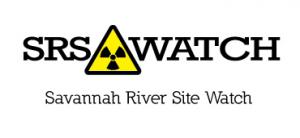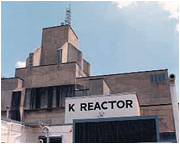DOE Releases Draft EIS on Unjustified Versatile Test Reactor; Cost, Safety, Plutonium Proliferation Risks Unacceptable

Savannah River Site Watch (SRS Watch) in Columbia, SC is a non-profit organization working on sound policies and projects by the U.S. Department of Energy, with a focus on the Savannah River Site. See our website at https://srswatch.org/

Old K-Reactor at SRS, being considered for fabrication of 30 metric tons of plutonium into fuel for the Verstaile Test Reactor. Currently, 11.5 MT of plutonium are stored in the K-Reactor. The reactor began operation in 1954 and operated until the late 1980s.
Proposed, Unneeded Versatile Test Reactor (VTR) to Cost $3 Billion to $6 Billion; Safety and Proliferation Risks of Plutonium-Fueled VTR Must be Reviewed
COLUMBIA, SC, US, December 21, 2020 /EINPresswire.com/ -- Despite safety and proliferation concerns and lack of justification, the U.S. Department of Energy has announced that it has released a draft Environmental Impact State on the Versatile Test Reactor (VTR).
The DOE Office of Nuclear Energy’s "Notice of Availability of Draft Versatile Test Reactor Environmental Impact Statement" appeared in the Federal Register on December 21, 2020. DOE’s Idaho National Lab (INL) is the preferred location for the reactor, with Oak Ridge National Lab as an alternative. Both INL and the Savannah River Site (SRS) in South Carolina are to be considered for fabrication of the reactor’s fuel, which could contain weapon-grade plutonium. The draft EIS presents the old K-Reactor at SRS as the site for fuel fabrication, with the shuttered L-Reactor also being considered, with up to 30 metric tons of plutonium to be imported for the project if it were to go forward.
Given that no clear mission need has been established for the VTR and with an estimated price tag of $3 billion to $6 billion, with completion ranging from 2026 to 2030, it is doubtful if the project will go forward. Just as for other costly, complex DOE projects, the price tag is certain to grow and the schedule certain to slip if the project is pursued. As there appears to be a rush in moving forward with the VTR in the waning days of the Trump administration, the need for the VTR, its cost and proliferation risks must be formally reviewed in 2021, according to the public interest group Savannah River Site Watch, and no final EIS issued.
The reactor would be a sodium-cooled “fast” reactor, based on the design of GE’s PRISM reactor, a reactor never before constructed, which is based on the long-closed Experimental Breeder Reactor II located at INL. While DOE has claimed that the VTR would not be operated to “breed,” or produce, plutonium it is in a class of reactor that operates on plutonium-uranium fuel and that can produce plutonium, posing significant proliferation risks. Given the exorbitant costs, impracticality and safety and proliferation risks of breeder reactors, all but a few countries have abandoned their programs.
DOE proposes that the VTR would operate for 60 years. As the reactor could use around 500 kilograms per year as fuel, the site selected for fuel fabrication would thus receive around 30 metric tons of plutonium. (The notice says plutonium use annually in fuel would be “between 0.4 and 0.54 metric tons of plutonium.”) Bringing an additional 30 MT of plutonium to SRS for this questionable mission is not acceptable, according to SRS Watch.
SRS, which has no recent fuel fabrication experience and which recently faced the termination of the mismanaged plutonium fuel (MOX) project, would be an extremely poor choice for VTR fuel fabrication, and must be rejected, according to SRS Watch. Underscoring the proliferation risks involved in fuel manufacture, the plutonium for the fuel would likely come from plutonium “pits” withdrawn from nuclear warheads and now stored at the Pantex site in Texas. Or, plutonium might be imported from the UK or France, which would also pose proliferation risks and involve unacceptable sea transport.
“Given that DOE has just rejected fabrication of plutonium MOX fuel at the SRS, it is totally absurd for any consideration to now be given to fabrication of VTR plutonium fuel at SRS,” said Tom Clements, director of Savannah River Site Watch in Columbia, SC. “SRS has lost all memory of fuel fabrication and could never reestablish that capability over the next decade,” added Clements. “The SRS fuel-fabrication alternative, like the overall project itself, simply isn’t viable and South Carolina does not want another risky project that could result in yet more plutonium being stranded in South Carolina,” Clements said. SRS Watch supports the "no-action alternative," under which the VTR would not be constructed.
In addition to 11.5 metric tons of plutonium currently being stored in the old K-Reactor at SRS, the site faces the import of an additional 7.5 metric tons of plutonium if the proposed SRS Plutonium Bomb Plant goes forward. That facility, now facing growing opposition, would produce plutonium “pits,” or cores for old and unneeded new nuclear warheads (including the W87-1 and W93). Likewise, SRS faces import of 20 MT or more of plutonium for the “plutonium disposition” program. DOE announced on December 16, 2020 that a “scoping” for an EIS on plutonium disposition at SRS had begun. According to SRS Watch, the various plans for importing more plutonium to SRS for the VTR, plutonium pits and for plutonium disposition need to be reviewed in an overarching manner and not in piecemeal environmental documents.
In the Federal Register notice, DOE says that a 45-day comment period on the draft EIS will soon begin.
If DOE needs a “fast-neutron” source for experimentation, it could modify existing reactors, including the Advanced Test Reactor or the High Flux Isotope Reactor, for that mission.
SRS Watch is a member of the Alliance for Nuclear Accountability (ANA), a network of public interest groups located near DOE sites.
###
1. Federal Register / Vol. 85, No. 245 / Monday, December 21, 2020 / Notices - "Notice of Availability of Draft Versatile Test Reactor Environmental Impact Statement," https://www.govinfo.gov/content/pkg/FR-2020-12-21/pdf/2020-27951.pdf
2. Draft VTR EIS, posted December 21, 2020, https://www.energy.gov/nepa/downloads/doeeis-0542-draft-environmental-impact-statement
3. See discussion of VTR cost and funding for Fiscal Year 2021: "Energy and Water Development: FY2021 Appropriations," by Congressional Research Service, December 8, 2020, https://crsreports.congress.gov/product/pdf/R/R46384
4. DOE document with $3 billion to $6 billion cost: Thomas J. O’Connor, VTR Program Director, DOE Office of Nuclear Energy, “Versatile Test Reactor Update,” March 28, 2019, https://www.energy.gov/sites/prod/files/2019/04/f61/VTR%20NEAC%20Rev%202%20%28003%29_1.pdf
5. For amount of plutonium in fuel, also see: "Scoping Analysis of Sodium Cooled Fast Spectrum Test Reactor Cores," Idaho National Lab, January 2020, https://inldigitallibrary.inl.gov/sites/sti/sti/Sort_21975.pdf
6. "DOE’s Formal Decision to Pursue Plutonium Bomb Plant at SRS Draws Immediate Criticism, Faces Potential Legal Challenge," SRS Watch news, Nov. 5, 2020, https://srswatch.org/does-formal-decision-to-pursue-plutonium-bomb-plant-at-srs-draws-immediate-criticism-faces-potential-legal-challenge/
Thomas W Clements
SRS Watch
email us here
+1 803-834-3084
Legal Disclaimer:
EIN Presswire provides this news content "as is" without warranty of any kind. We do not accept any responsibility or liability for the accuracy, content, images, videos, licenses, completeness, legality, or reliability of the information contained in this article. If you have any complaints or copyright issues related to this article, kindly contact the author above.

